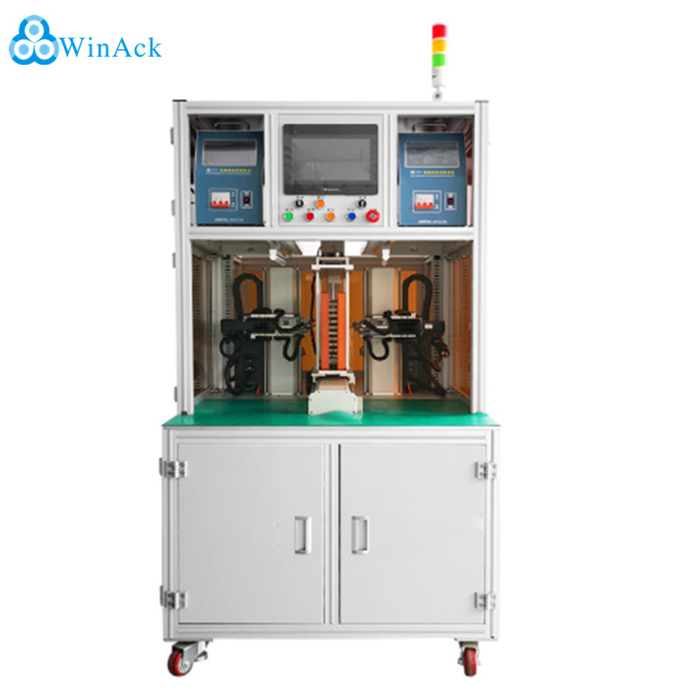In the battery pack process, resistance welding, as a relatively mature process, is used in some occasions, such as the welding of battery cells and busbars, the connection of battery tabs and parallel conductive bars, and so on.
Due to the simple equipment and low cost, the battery resistance welding machine has been widely used in the battery industry.
The battery resistance welding machine has the advantages of good working conditions, no additional welding materials, simple operation, and easy mechanization.
However, the battery resistance welding machine is also limited by factors such as high-power consumption, electrode rod replacement, conductivity of the welded material, applicable joint form, and weldable workpiece thickness (or cross-sectional size).
Working principle of battery pack spot welding machine
Most common battery pack spot welding machines are battery resistance welding machines. The battery resistance welding machine is a welding method in which the battery and the nickel strip are clamped between a certain electrode force, and then the nickel strip is melted by the resistance heat precipitated by the nickel strip through the current, and a reliable welding point is formed after cooling.
The working principle of the battery pack spot welding machine is as follows: the battery and the nickel strip are pressed tightly through the electrodes, and after a certain connection pressure is applied, the welding power source releases a larger current in the welding zone and continues for a certain time until the nickel sheet and the battery After the actual contact point appears between the contact surfaces of the nickel sheet, continue to increase the welding current to make the nugget continue to grow. At this time, the atoms at the contact position of the nickel strip are continuously activated to form a molten core. Finally, the welding power supply stops energizing, and the melted nickel strip is condensed into a welding point.
The battery spot welder is a method that uses the resistance heating effect generated by the current flowing through the contact surface of the nickel strip and the adjacent area to heat the nickel strip to a molten state to form a metal bond.

Four stages of the welding process of the battery pack spot welding machine
When spot welding, pressure is applied to make the two workpieces come into close contact, and then the current is turned on. The resistance heat generated by the current flow causes the local metal to be melted to form a liquid nugget. After the power is cut off, continue to maintain the pressure or increase the pressure to make the nugget solidify and crystallize under the pressure to form a dense point.
After welding one point, the electrode (or workpiece) will move to another point for welding. When welding the next point, a part of the current will flow through the welded point, which is called shunting. The shunt will reduce the current at the welding site and affect the welding quality. Therefore, there should be a certain distance between two adjacent points.
The main factors that affect the quality of solder joints are connection current, energization time, electrode pressure and surface cleaning of the workpiece. Spot welding is mainly suitable for thin plate parts, one point at a time or multiple points at a time.
Generally, the spot welding process of a battery pack spot welding machine is composed of four stages: pre-compression, welding, maintenance and rest. The welding time, welding current and electrode voltage are its basic parameters.
Pre-compression stage: This stage mainly completes the application of electrode force. After the electrode is in contact with the nickel strip, a constant electrode pressure is maintained to ensure that the current channel remains stable during the energization process. Therefore, the pre-compression stage needs a certain duration.
Welding stage: As the main stage of nugget forming, this stage requires the effective connection current to remain basically unchanged or to fluctuate in a small range. At this stage, the temperature distribution of the welding zone gradually stabilized after very complicated changes. At first, the heat input between the parts is much greater than the heat dissipation, so the temperature of the welding zone rises rapidly, and a high-temperature connection zone is formed. At this time, the outside air is in a barrier state with the molten parts in the welding center, so the weldment material will not interact with the air. Oxidation reaction. After a certain period of time, the area of the melting zone becomes larger, and its plastic ring also becomes larger, until the input heat and the lost heat reach a stable state.
Maintenance phase: In this phase, the electrode remains in the same state as the previous two phases, except that no current is passed through at this time. This stage is mainly to complete the dissipation of heat in the nugget to cool down and form a reliable point.
Resting phase: In this phase, the current and electrode pressure are both zero. As the electrode rises, remove the object to be welded, and start preparing for the next welding process.
Contact: WinAck
Phone: 0086- 188 0506 7911
Tel: 0086- 592 - 7297239
Email: timi@winack.com
Add: WinAck Group, Xiangbei Industrial Zone, Xiamen City, China